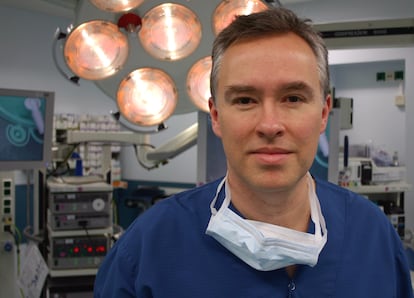From Albert Einstein to Harry Houdini: A compendium of historic surgeries
In ‘Under the Knife,’ Arnold Van de Laar presents a collection of anecdotes from the operating room, with protagonists ranging from Kennedy to the ancient Romans


In 1948, Albert Einstein entered the operating room with an abdominal aortic aneurysm – an abnormal dilation of the artery caused by the weakening of the arterial wall. Surgical medicine was still unable to properly address this problem, so his surgeon decided to wrap it in cellophane. The scientist survived seven more years, although whether it was thanks to this measure or out of sheer luck is up to debate. The same surgeon who tried to save the life of John F. Kennedy after his attack in Dallas in 1963 had the alleged assassin Lee Harvey Oswald on his operating table a few days later, although he could not do anything to prevent his death either.
Dutch surgeon Arnold Van de Laar recounts these and other historic operations in the book Under the Knife. There are many stories about famous operations, he points out, but they were not written by doctors. This is what drove him to pen this book from a medical perspective so that no information would be lost.
The death of Austrian Empress Sissi from a pierced pericardium after being stabbed with a stiletto knife, Houdini’s last performance with the acute appendicitis that killed him and the tummy tucks they used to perform in Ancient Rome are some of the stories that the readers can find throughout the book.
The author acknowledges that one of the weaknesses of his field is the great respect that many young surgeons have for the veterans. “They should not listen to their advice,” he points out; instead, they ought to “look into the evidence that is now being published in scientific papers.” To exemplify his point, he mentions the case of Theodor Billroth, the father of abdominal surgery: “[He] said you should never do an operation on the heart. And he never explained why he said it, but because he was the expert, nobody dared to do it.”
Van de Laar is a general surgeon specializing in gastrointestinal surgery. He began his career in 2001 on the island of Saint Martin and is the first doctor in his family. “In secondary school, I liked biology,” he explains. “And I was very interested in how things work in our body. And I love to work with my hands, so it just came together.”
Before anesthesia was invented in the 19th century, patients were awake during surgeries. This, in addition to enormous suffering, could cause post-traumatic stress disorder in the patient. For this reason, it was important for surgeons to operate quickly, recounts Van de Laar in the book. He is clear that he would not have been able to practice at that time: “I don’t think I would have had the nerve and the conscience to be a surgeon.”
To exemplify the horror that this entailed for the patients, he tells the story of Frances Burney, a British writer who had her breast removed. The surgeons who treated her diagnosed her with cancer and removed her entire breast without any sedation. Burney was traumatized, but lived another 30 years.
With today’s knowledge, the writer doubts that it was actually breast cancer. However, he does not think that the operation was a medical mistake, because the patient survived. “They really thought it was necessary,” says the Dutchman. “Nowadays we would maybe not have done that operation in her case, but they could not have known that.”
The present and future of surgery
Van de Laar acknowledges that women are the future of his profession. More and more female surgeons are entering hospitals and the author believes that parity will be achieved, even if today the presence of men is still the norm: “I’m still working in a hospital where [out of 25 surgeons] we have only two women working.”
The author also talks about the evolution of the doctor-patient relationship. People still trust their doctors, he points out, but they also question more the advice they receive. Two or three decades ago, if a surgeon recommended an operation, the patient accepted it without objection, while “nowadays, more and more patients will say, well, explain why you think I need the operation.” To him, that is a positive shift: “You should never trust the doctor. You should always trust the evidence.”
What’s more, most operations today start out as a multidisciplinary consultation between the surgeon and all the specialists, so it is not an individual decision, he says. This way of working also helps to reach a consensus between surgeons and internists.
The surgeon acknowledges a tendency to operate less. Five years ago, if a person was in a car accident and their spleen ruptured, they had to be operated on quickly to prevent them from bleeding to death. “Now we don’t do the operation anymore, because they can go within the blood vessels and stop the bleeding,” he explains.
Tu suscripción se está usando en otro dispositivo
¿Quieres añadir otro usuario a tu suscripción?
Si continúas leyendo en este dispositivo, no se podrá leer en el otro.
FlechaTu suscripción se está usando en otro dispositivo y solo puedes acceder a EL PAÍS desde un dispositivo a la vez.
Si quieres compartir tu cuenta, cambia tu suscripción a la modalidad Premium, así podrás añadir otro usuario. Cada uno accederá con su propia cuenta de email, lo que os permitirá personalizar vuestra experiencia en EL PAÍS.
¿Tienes una suscripción de empresa? Accede aquí para contratar más cuentas.
En el caso de no saber quién está usando tu cuenta, te recomendamos cambiar tu contraseña aquí.
Si decides continuar compartiendo tu cuenta, este mensaje se mostrará en tu dispositivo y en el de la otra persona que está usando tu cuenta de forma indefinida, afectando a tu experiencia de lectura. Puedes consultar aquí los términos y condiciones de la suscripción digital.
More information
Archived In
Últimas noticias
There is as much life left to discover on planet Earth as that which is already known
Dozens presumed dead, around 100 injured in fire at Swiss Alps bar during New Year’s celebration
Is porn for women different from conventional porn? We spoke to those who make it
Cartagena de Indias is sinking: What can the city do to mitigate it?
Most viewed
- David King, chemist: ‘There are scientists studying how to cool the planet; nobody should stop these experiments from happening’
- Reinhard Genzel, Nobel laureate in physics: ‘One-minute videos will never give you the truth’
- Oona Chaplin: ‘I told James Cameron that I was living in a treehouse and starting a permaculture project with a friend’
- Sinaloa Cartel war is taking its toll on Los Chapitos
- The Interoceanic Train, the Mexican alternative to the Panama Canal










































